39 integumentary system labels
Skin Layers: Structure, Function, Anatomy, and More - Verywell Health The integumentary system is a collection of organs that includes the skin, hair, nails, endocrine glands, and sensory nerves. The primary function of this system is to protect the body from external elements, such as bacteria or pollution. Learn More: The Integumentary System: Skin, Hair, Nails, Glands. Integumentary System Labeling Diagram | Quizlet Integumentary System Labeling 4.8 (29 reviews) + − Flashcards Learn Test Match Created by Bethany_Thiele Terms in this set (14) Epidermis The most superficial section of skin, made up of epithelial tissue Dermis Below the epidermis, and above the hypodermis, this section of skin contains many structures including blood vessels Hypodermis
integumentary system labeling Flashcards and Study Sets - Quizlet Learn integumentary system labeling with free interactive flashcards. Choose from 5,000 different sets of integumentary system labeling flashcards on Quizlet. Svg Vector Icons :

Integumentary system labels
What Are the 5 Parts of the Integumentary System? - MedicineNet The 5 parts of the integumentary system—skin, hair, nails, glands, and nerves—protect the body from environmental elements The integumentary system is made up of organs and structures that protect the inside of the body from environmental elements. The 5 parts of the integumentary system include: Skin Hair Nails Glands Nerves Skin Integumentary System | Medical Terminology in a Flash! A Multiple ... Let's look at the structure and function of the integumentary system. + + The skin consists of three layers . The ... Draw and label what you see. + + The dermis lies just beneath the epidermis and is much thicker. It is made of fibrous connective tissue containing elastin, which provides elasticity, and collagen, which provides strength. ... Integumentary System Histology Illustrations Integumentary System Histology Illustrations: Skin - histology illustrations: Skin - histology illustration: Skin (labels) - illustration: ... Papilla of the hand (labels) - histology illustration: Pacinian corpuscle (labels) - histology illustration: 24 files on 2 page(s) 1: 2:
Integumentary system labels. Solved Drag the labels onto the diagram to identify the - Chegg Drag the labels onto the diagram to identify the components of the integumentary system. Reset Stre Cutaneous embra Har shaft Pore swear gland duct Talle COCOLISCIA Seondecus gland. rectomp muscle Hair follicle cam QUISA Swearglana du Sweat gland Nerve fibers Submit Previous Answers Request Answer The Layers of the Integumentary System - ThoughtCo The integumentary system is the body's first line of defense against bacteria , viruses, and other pathogens. It also helps provide protection from harmful ultraviolet radiation. The skin is a sensory organ, too, with receptors for detecting heat and cold, touch, pressure, and pain. Labelled Integumentary System - SlideShare Integumentary System Model. Just for you: FREE 60-day trial to the world's largest digital library. The SlideShare family just got bigger. Enjoy access to millions of ebooks, audiobooks, magazines, and more from Scribd. integumentary system labeling worksheet skin label structures integumentary system lab revi solved date name. Lab 6 Integumentary System studylib.net. worksheet integumentary system skin worksheets lab label structures areas indicated revised leader lines study studylib doc science brackets. Integumentary• Skin Is A Soft Outer Covering Of The Body.• In Mammals ...
Anatomy of the Integumentary System - Verywell Health The integumentary system includes organs and structures such as the skin, hair, nails, glands, and nerves. The primary function of the integumentary system is to serve as a barrier between the inside of the body and elements in the environment like bacteria, pollution, and UV rays from the sun. Integumentary System - Diagram - How It Works | Live Science The integumentary system, or skin, is the largest organ in the body. Besides the skin, it comprises the hair and nails as well, which are appendages of the skin. In humans, this system accounts ... Integumentary System (labeling) Quiz - Quizizz Question 9. SURVEY. 60 seconds. Q. Identify the structure indicated by the red arrow. answer choices. blood vessels. sebaceous glands. Integumentary System Anatomy and Physiology - Nurseslabs Anatomy of the Integumentary System The skin and its derivatives (sweat and oil glands, hair and nails) serve a number of functions, mostly protective; together, these organs are called the integumentary system. Structure of the Skin The skin is composed of two kinds of tissue: the outer epidermis and the underlying dermis. Epidermis
Integumentary system The integumentary system summary. Skin: The skin is the most important organ of the body. Epidermis: are keratinized and dead cells that make the skin waterproof. Dermis: The sweat glands are present in this layer that collect waters and waste products from the blood stream. The hair roots are also present in this layer that help in the growth ... Integumentary system: Definition, diagram and function | Kenhub The integumentary system is supplied by the cutaneous circulation, which is crucial for thermoregulation. It consists of three types: direct cutaneous, musculocutaneous and fasciocutaneous systems. The direct cutaneous are derived directly from the main arterial trunks and drain into the main venous vessels. The Integumentary System | Anatomy and Physiology I | | Course Hero The integumentary system refers to the skin and its accessory structures, and it is responsible for much more than simply lending to your outward appearance. In the adult human body, the skin makes up about 16 percent of body weight and covers an area of 1.5 to 2 m 2. In fact, the skin and accessory structures are the largest organ system in ... Integumentary System - Building a Medical Terminology Foundation The integumentary system refers to the skin and its accessory structures. In the adult human body, the skin makes up about 16 percent of body weight and covers an area of 1.5 to 2 m 2. In fact, the skin and accessory structures are the largest organ system in the human body.
Diagrams - The integumentary system Diagram of the skin and hair (includes sweat gland) Skin: Tissue creating an external covering of the body. Epidermis: The upper layer of skin composed of the Stratum Corneum, stratum Lucidum, Stratum Granulosum, Stratum Spinosum, and Stratum Germinativum. The Stratum Corneum: The outermost layer of skin consisting of dead and Keratinization cells.
Integumentary system - Wikipedia The integumentary system, sometimes called the exocrine system, is the set of organs forming the outermost layer of an animal's body. It comprises the skin and its appendages, which act as a physical barrier between the external environment and the internal environment that it serves to protect and maintain the body of the animal.
Integumentary System | histology - University of Michigan 1. Letter A labels the reticular dermis, so named because of the network of coarse, type I collagen fibers (Letter B indicates the papillary dermis). 2. Letter C labels Meissner's corpuscles, which are mechanosensory receptors that respond primarily to light touch and low frequency stimuli. 3.
Integumentary System: What It Is, Function & Organs - Cleveland Clinic Your integumentary system is your body's outer layer. It consists of your skin, hair, nails and glands. These organs and structures are your first line of defense against bacteria and help protect you from injury and sunlight. Your integumentary system works with other systems in your body to keep it in balance. Appointments 216.444.5725.
Integumentary System Labeling Quiz - PurposeGames.com An unregistered player played the game 3 days ago About this Quiz This is an online quiz called Integumentary System Labeling There is a printable worksheet available for download here so you can take the quiz with pen and paper. From the quiz author Select the correct structure found in the Integumentary System. Your Skills & Rank Total Points 0
5 Chapter 5 The Integumentary System - viva.pressbooks.pub The skin and its accessory structures make up the integumentary system, which provides the body with overall protection. The skin is made of multiple layers of cells and tissues, which are held to underlying structures by connective tissue. ... Sketch the skin and label the parts of the integument shown in Figure 5.2 above, observed at low and ...
Integumentary System Labeling and Questions worksheet student.docx ... Integumentary System Objectives Checklist. After completion of this lab you should be able to: list the general functions of the integumentary system and explain how the skin and its accessory organs carries out these functions identify the structures of the skin and its accessory organs as well as the different types of tissues and cells that make up the major layers of the skin compare the ...
Integumentary System: Definition, Function, Organs & Diseases The integumentary system is the set of organs that forms the external covering of the body and protects it from many threats such as infection, desiccation, abrasion, chemical assault and radiation damage. IN humans the integumentary system includes the skin - a thickened keratinized epithelium made of multiple layers of cells that is largely impervious to water.
Integumentary system parts: Quizzes and diagrams | Kenhub One of the best ways to start learning about a new system, organ or region is with a labeled diagram showing you all of the main structures found within it. Not only will this introduce you to several new structures together, it will also give you an overview of the relations between them. Enter: our integumentary system quiz and answer worksheets.
Hole's Human Anatomy & Physiology | Labeling Exercises Labeling Exercises. Labeling Exercise 1. Labeling Exercise 2. Labeling Exercise 3. Labeling Exercise 4. Labeling Exercise 5. Labeling Exercise 6.
Question : Label the appropriate body systems. Digestive system ... - Chegg Question: Label the appropriate body systems. Digestive system Endocrine system Lymphatic system Muscular system Integumentary system This problem has been solved! See the answer label the approrpiate body systems Show transcribed image text Expert Answer 100% (21 ratings)
Integumentary System Histology Illustrations Integumentary System Histology Illustrations: Skin - histology illustrations: Skin - histology illustration: Skin (labels) - illustration: ... Papilla of the hand (labels) - histology illustration: Pacinian corpuscle (labels) - histology illustration: 24 files on 2 page(s) 1: 2:
Integumentary System | Medical Terminology in a Flash! A Multiple ... Let's look at the structure and function of the integumentary system. + + The skin consists of three layers . The ... Draw and label what you see. + + The dermis lies just beneath the epidermis and is much thicker. It is made of fibrous connective tissue containing elastin, which provides elasticity, and collagen, which provides strength. ...
What Are the 5 Parts of the Integumentary System? - MedicineNet The 5 parts of the integumentary system—skin, hair, nails, glands, and nerves—protect the body from environmental elements The integumentary system is made up of organs and structures that protect the inside of the body from environmental elements. The 5 parts of the integumentary system include: Skin Hair Nails Glands Nerves Skin


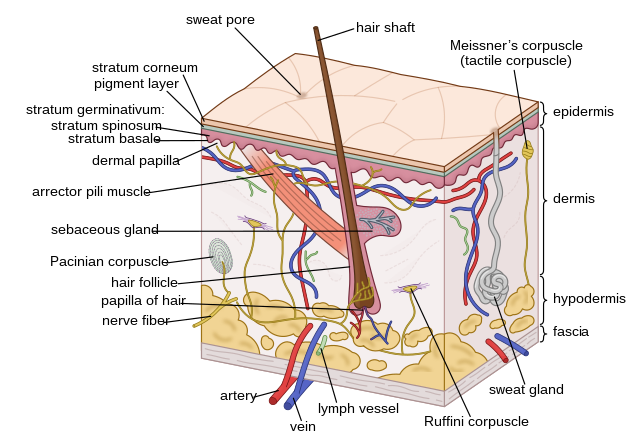








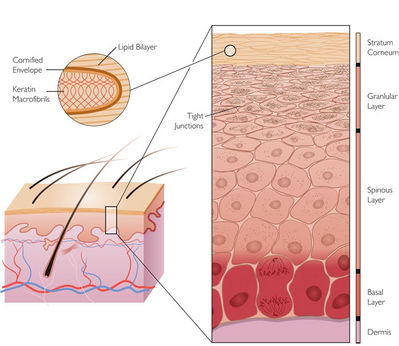
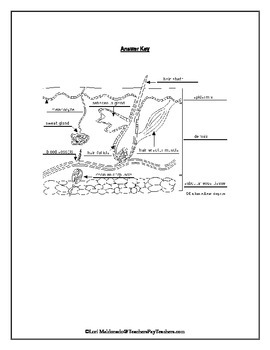






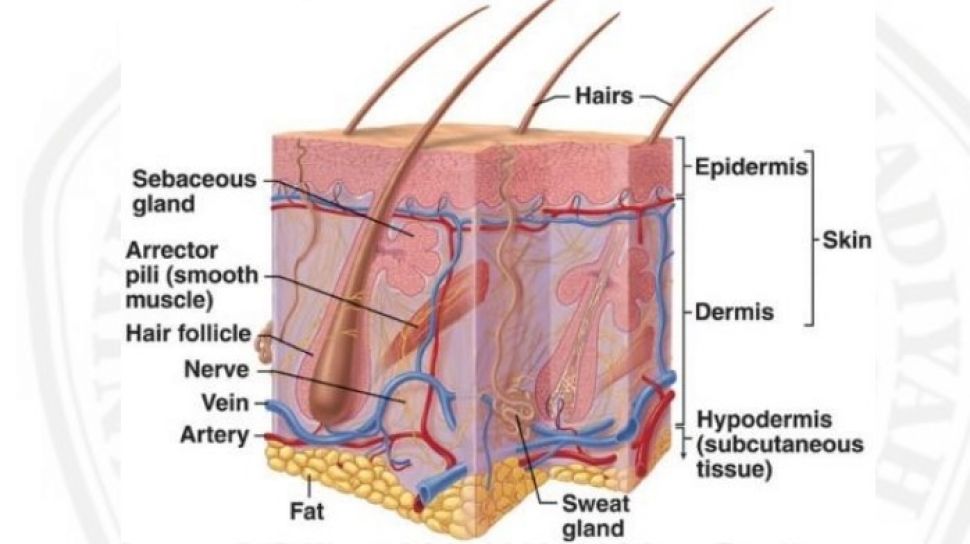

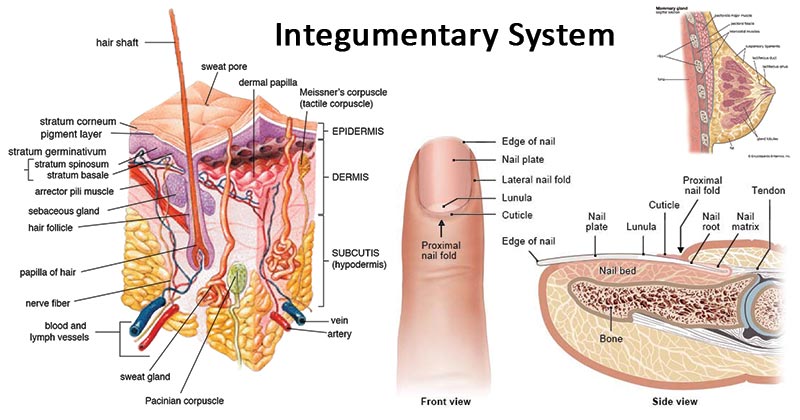

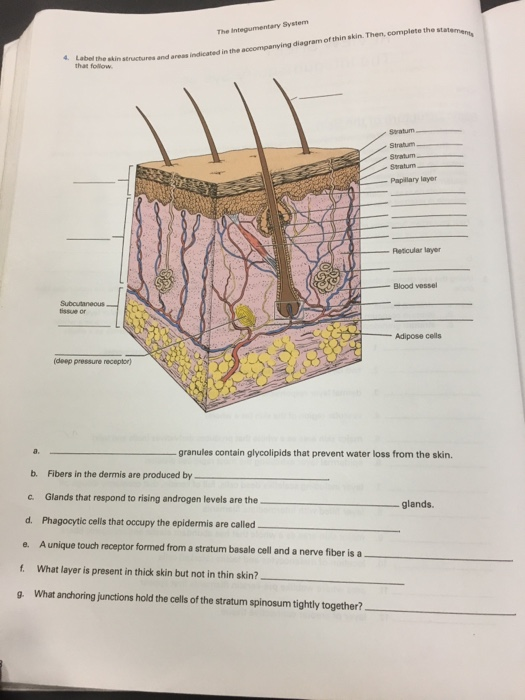







Post a Comment for "39 integumentary system labels"